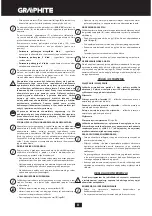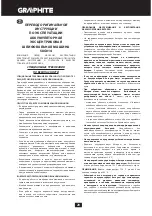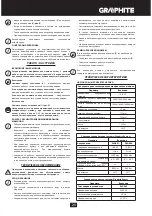
12
-
Carefully wipe the liquid with a cloth. Avoid contact of the liquid
with skin and eyes.
-
In case the liquid gets onto skin, immediately wash the spot
abundantly with clean water, you can also neutralize the liquid
with a mild acid, e.g. lemon juice or vinegar.
-
When the liquid gets into eyes, wash it immediately with a lot of
clean water for at least 10 minutes. Seek medical advice.
• Do not use damaged or modified battery.
Damaged or
modified batteries may behave unpredictably, causing fire,
explosion or risk of injuries.
• Do not expose the battery to humidity or water.
•
Always keep the battery away from sources of heat. Do not
leave the battery for a long time in high temperature (in
direct sunlight, in proximity of heaters and wherever the
temperature exceeds 50°C).
• Do not expose the battery to fire or excessive temperature.
Exposure to fire or temperature above 130°C may cause explosion.
CAUTION!
Temperature of 130°C can be also defined as 265°F.
• Observe all charging instructions. Do not charge the battery
in temperature outside of range defined in the rating data
table from the instruction manual.
Incorrect charging or
charging in temperature outside of defined range may damage the
battery and increase the risk of fire.
BATTERY REPAIRS
• Do not repair damaged batteries.
Battery can be repaired
only by the manufacturer or in an authorised workshop.
• When disposing of the worn out battery, take it to a service
point where you can utilize such dangerous wastes.
SAFETY REGULATIONS FOR THE CHARGER
• Do not expose the charger to humidity or water.
Ingress of
water into the charger increases risk of electric shock. Use the
charger only in dry rooms.
•
Disconnect the charger from power supply before starting any
maintenance or cleaning.
• Do not use the charger when placed on flammable
surface (e.g. paper, textiles) or in proximity of flammable
substance.
Greater charger temperature when charging
increases risk of fire.
• Check condition of the charger, cable and plug before each
use. Do not use the charger if any damage is found. Do not
try to disassemble the charger.
All repairs should be made at
an authorized service workshop. Improper charger assembly may
cause electric shock or fire.
•
Children or persons who are physically, emotionally or
mentally disabled and other persons, whose experience or
knowledge is insufficient to use the charger while following all
safety rules should not use the charger without supervision of
person responsible for their safety. Otherwise there is a risk of
improper use and injuries in consequence.
• When the charger is not in use, it should be disconnected
from the mains network.
• Observe all charging instructions. Do not charge the
battery in temperature outside of range defined in the
rating data table from the instruction manual.
Incorrect
charging or charging in temperature outside of defined range
may damage the battery and increase the risk of fire.
CHARGER REPAIRS
• Do not repair damaged charger.
The charger can be repaired
only by the manufacturer or in an authorised workshop.
• When disposing of the worn out charger, take it to a service
point where you can utilize such wastes.
CAUTION! This device is designed to operate indoors.
The design is assumed to be safe, protection measures and
additional safety systems are used, nevertheless there is
always a small risk of injuries at work.
Li-Ion batteries may leak, set on fire or explode when
heated to high temperature or short-circuited. Do not store
the batteries in a car in hot and sunny days. Do not open
the battery. Li-Ion batteries contain electronic protection
devices that, if damaged, may cause fire or explosion of the
battery.
Explanation of used symbols
1
2
3
Max.
50°C
4
5
6
7
10
9
8
11
12
1.
Read instruction manual, observe warnings and safety
conditions therein.
2.
Use protective goggles and hearing protectors.
3.
Work with protective mask on.
4.
Keep the tool away from children.
5.
Protect against rain.
6.
Use indoors, protect from water and moisture.
7.
Recycling.
8.
Protection class 2.
9.
Segregated waste collection.
10.
Do not throw cells into fire.
11.
Hazardous to water environment.
12.
Do not allow to heat above 50°C.
CONSTRUCTION AND USE
Orbital sander is a battery-powered tool. The drive consists of
DC commutator motor with permanent magnets. Orbital sander
is designed for sanding and polishing surfaces of wood, metal,
plastic and similar materials, with the use of sanding paper with
appropriate gradation. Range of use covers repair and building
works, and any work from the range of individual, amateur
activities (tinkering).
Do not use the sander for sanding surfaces that contain
magnesium or asbestos, or covered with gypsum.
DESCRIPTION OF DRAWING PAGES
Below enumeration refers to the device elements depicted on
the drawing pages of this manual.
1.
Off switch
2.
On switch
3.
Dust bag
4.
Dust extraction outlet
5.
Backing pad
6.
Battery lock button
7.
Battery
8.
Charger
Summary of Contents for 58G014
Page 2: ...2...
Page 4: ...4 0 3 2 1 5 2 1 4 3...
Page 5: ...5 B 7 8 9 7 10 11 C 5 a D a E 3 4 F 3 G 2 1 0 3 2 1 A 6 7...
Page 20: ...20 58G014 0 C 10 50 C 130 130 265 F...
Page 25: ...25 58G014 0 C 10 50oC 130 C 130 C 265 F...
Page 62: ...62 58G014 0o C 10 50 C 130 C 130 C 265 F...
Page 75: ...75 00 C 10 50 C 130 130 265 F Li ion Li ion...
Page 77: ...77 9 11 15 11 8 3 11 10 C 2 1 5 a 5 D 3 3 4 F 3 2 1 G 3 2 1...
Page 92: ......













































